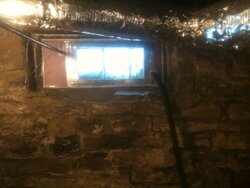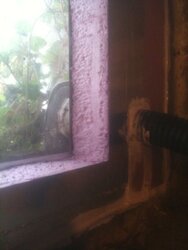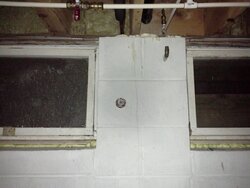Here's sort of a copycat idea that was inspired from the recent threads here on interior storm windows... I have a real old single pane basment window that was leaking really bad. To seal it, I took a scrap piece of 2" thick pink foam insulation board and first cut it to the dimensions of the window opening. Then I whittled the edges with a sharp knife until I got a nice tight fit into the window recess. Next I removed the foam board and cut a new "window" (12"x20") out of the center of the foam board. I bought two pices of polycarbonate sheet (about 14"x24", maybe) at HD and glued the outer perimeter of the polycarbonate sheet to one side of the insulation board with silicone sealant. Then I overlapped some spare foil tape (maybe 3" wide) over the top of the polycarbonate where the glue line is to give it some quick strength and hide the silicone. I did the same with the other side of the polycarbonate. I pressed my new window into place and caulked it with silicone. As you can see from the pictures, it's not pretty to look at, but it did an EXCELLENT job sealing it up. The window stopped sweating on the inside, and all of the draft is gone. Thought somebody else with an unfinished basment might find this useful. I forgot to mention earlier, but I also had to cut out holes for my sump pump hose and my wood boiler pressure relief piping, both of which pass through the window, which I modified years ago. This foam board was a simple solution to an otherwise messy problem, since I could cut around the obstacles and then reglue the cut-out pieces.
Cost: $20 for the glazing, $4 for the caulk, about 3hours work, and 3 beers for the laborer
Thanks for the idea!

Cost: $20 for the glazing, $4 for the caulk, about 3hours work, and 3 beers for the laborer

Thanks for the idea!




